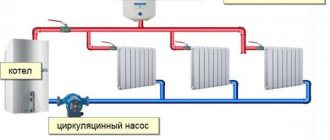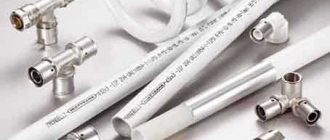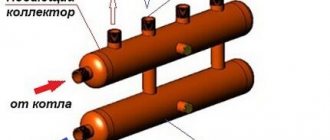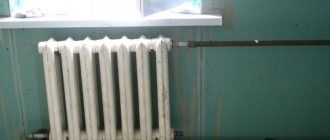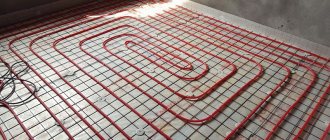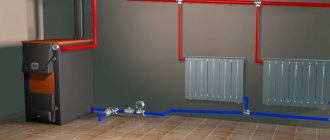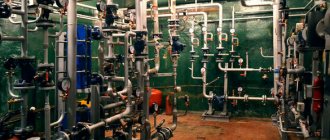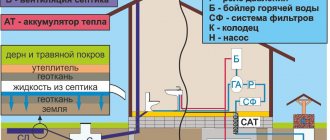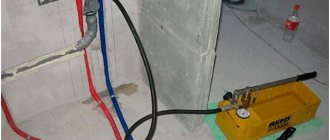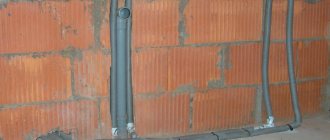Are you planning to change the heating appliances in your own home? For this, knowledge about the types of battery wiring, methods of connecting and placing them will be useful. Agree, because the correctness of the selected connection diagram for heating radiators in a particular house or room directly determines its effectiveness.
Correctly connecting the batteries is a very important task, because it can provide all rooms with a comfortable temperature at any time of the year. It’s good when fuel consumption is minimal and your home is warm on the coldest days.
We'll help you understand what you need to get your radiators running as efficiently as possible. In the article you will find a lot of useful information about ways to connect batteries and their implementation without the involvement of specialists. Diagrams and videos are provided that will help you clearly understand the essence of the issue.
Types of heating systems
The heating system in a private house can be:
- air;
- electrical;
- water.
Air system
This option operates without coolant. The air in the house is heated directly from heating devices - stoves or convectors. With this system, heating radiators are not used. Air heating is convenient for heating compact country houses. For large cottages it is used extremely rarely.
Electrical system
In such a system, heat is transferred through current conductors. Electric underfloor heating works on this principle. Heating using an electric system can be quite convenient. But its arrangement requires increased attention to safety rules, and during operation it is expensive for home owners.
Water system
A type of heating system in which heat is transferred through water (sometimes steam) as a coolant. The coolant flows from the heating device through pipes to the heating radiators. This option is considered the most convenient and practical. Most often, in country houses, heating is installed in this way.
Water heating of a private house Source heatsun.net
Advantages and disadvantages of a single-pipe system
Single-pipe heating has gained wide popularity in the field of private construction.
The main reasons are the relatively low cost of the structure and the ability to install it on your own, without the involvement of specialists.
But a single-pipe heating system has other advantages:
- Hydraulic stability - the heat transfer of other elements of the system does not change when individual circuits are disconnected, radiators are replaced or sections are expanded;
- The construction of the main line requires a minimum number of pipes;
- It is characterized by low inertia and warm-up time due to the smaller amount of coolant in the line than in a two-pipe system;
- It looks aesthetically pleasing and does not spoil the interior of the room, especially if the main pipe is hidden;
- Installation of the latest generation shut-off valves - for example, automatic and manual thermostats - allows you to precisely adjust the operating mode of the entire structure, as well as its individual elements;
- Simple and reliable design;
- Easy installation, maintenance and operation.
When connecting control and monitoring devices to the heating system, it can be switched to a fully automatic operating mode.
Integration with the Smart Home system is possible - in this case, you can set programs for optimal heating modes depending on the time of day, season and other decisive factors.
A single-pipe heating line can be completely hidden with finishing. Such a device not only does not spoil the appearance of the room, but also becomes its detail - an interior item.
The main disadvantage of single-pipe heat supply is the imbalance of heating of heat-transfer batteries along the length of the main line.
The coolant cools as it moves along the circuit. Because of this, radiators installed far from the boiler heat up less than those located close to them. Therefore, it is recommended to install slowly cooling cast iron appliances.
Installing a circulation pump allows the coolant to warm up the heating circuits more evenly, however, if the pipeline is of sufficient length, significant cooling is observed.
The negative effects of this phenomenon can be reduced in two ways:
- In radiators remote from the boiler, the number of sections is increased. This increases their heat-conducting area and the amount of heat given off, allowing rooms to be heated more evenly.
- They draw up a project with a rational arrangement of heat-emitting devices in the rooms - the most powerful ones are installed in children's rooms, bedrooms and “cold” (northern, corner) rooms. As the coolant cools down, the living room and kitchen proceed, ending with non-residential and utility rooms.
Such measures minimize the disadvantages of a single-pipe system, especially for one- and two-story buildings with an area of up to 150 m². For such houses, single-pipe heating is the most profitable.
Types of heating boilers
The central element of the heating system is the boiler - a heating device in which the coolant reaches the desired temperature. The heating connection diagram in a private house largely depends on what kind of boiler is used in it.
According to their purpose, boilers are divided into double-circuit and single-circuit. The first option is equipment designed for both heating and water heating. A single-circuit boiler heats only the heating medium. According to the installation method, they are divided into floor and wall.
Boilers also differ in the type of fuel with which the coolant is heated. There are boilers of the following types:
- gas;
- electrical;
- solid fuel;
- liquid fuel;
- combined.
To operate solid fuel boilers, coal, firewood, and less often peat and other types of solid combustible materials are used. Diesel or waste oils are used as liquid fuel for boilers of the corresponding type.
Solid fuel water boiler in a private house Source otoplenie-gid.ru
Most country cottages are heated by gas boilers. In non-gasified areas, heating with electricity is often used. Solid fuel and liquid fuel boilers are completely independent of communication networks. The first option is more attractive because it requires traditional firewood and coal, rather than dangerous flammable liquids.
The most prudent homeowners install combination boilers in their homes, designed to operate on different types of fuel. For example, you can install an electric boiler, supplemented with a combustion chamber for solid fuel, so that in case of damage to the electrical network, switch to wood heating.
Double-circuit boilers that provide homes with heat and warm water are predominantly gas devices. They are universal, as they eliminate the need for homeowners to purchase and install a separate water heating boiler.
Scheme of double-circuit heating in a house Source pikucha.ru
See also: Catalog of companies that specialize in insulating country houses.
Where should the radiator integration take place?
It doesn’t matter whether the devices are connected in parallel or in series, heat supply is not the only function of such systems. Among other things, they must protect the room from drafts and cold winds.
This is why heating radiators are installed under window sills. Being in such a place, the devices create a good thermal curtain in the window area.
It is not recommended to install radiators next to each other, as this is fraught with large heat losses. The density of hot air decreases, which leads to a decrease in the efficiency of the heating system.
Before you begin connecting heating devices, you need to draw up a work plan where you need to designate the locations of all products. It is also important to calculate the installation distances that must be maintained when installing the device.
In order for the radiators to be positioned correctly, the following requirements must be taken into account:
- the distance from the window sill to the battery should be 100 mm;
- a gap of 120 mm is maintained between the floor and the radiator;
- the gap from the wall to the heating device should be 20 mm.
Heating radiator design
The heating radiator consists of several heat exchange sections. The more sections, the correspondingly higher the battery power. There are models of radiators that can be “expanded” with new sections, if necessary, already during operation.
One collector passes through all sections at the top and one at the bottom. Each section has a vertical channel connecting the upper and lower manifold. This applies to all sections, including the outer ones. Therefore, the radiator has 4 outputs, but only two of them are used. One is connected to the coolant supply pipe, and the second is used to drain cooled water back into the boiler. Unused outputs are closed with plugs. This is how most radiators are designed.
Heating radiator diagram Source mr-build.ru
Installation work
First, markings to ensure that the device is installed correctly and meets all regulatory requirements. Thanks to the marked points, you can see where the brackets will be fixed.
Several types of fasteners . The most common are special pins that are installed directly into the wall and then cemented.
Quite often corner brackets , which are fixed with dowels. For reliable fastening, two such elements are usually enough.
Before installing the radiator, you must first prepare the threaded connection . After this, all the necessary parts for venting air are attached to the heating device.
At the next stage, connect:
- locking equipment:
- control valves;
- fitting;
- union nuts;
- taps;
- thermostats.
All connections must be carefully sealed and secured with special keys.
Before applying the polymer composition, the tow must be wound clockwise when the thread is right-handed, and vice versa if it is left-handed. In this case, it is quite enough to make a few turns.
After installing the battery on the brackets, check its levelness using a building level. If necessary, the position can be corrected by adjusting the bracket.
It is worth noting that precise horizontal placement of the device is required only in pumping systems with counter-movement of air and coolant. Air pockets may appear in such pipes.
At low operating pressure, where liquid and air have the same direction, it is advisable to make a slight slope of the pipeline. This will ensure that the excess mixture of gases is diverted into the common pipeline.
To connect radiators to the riser, various types of pipes are installed. In the last few years, polypropylene products have become the most popular. They are easy to install and are quite cheap. Shut-off valves and other parts should also be made of this material.
When it is necessary to connect a battery with plastic cylindrical products to a metal riser, professionals recommend replacing this section of the vertical pipeline element with a polypropylene structure, which significantly extends the service life of the entire system.
Types of pipe system
In the heating system diagram, the relative position of the coolant supply inlet and the return outlet is of fundamental importance. This depends on the direction of the coolant and the type of pipe system.
Single pipe system
This is a simplified option for arranging heating in a cottage. This option is quite economical, since it requires fewer pipes for wiring and is carried out with less labor for installation work. The system is a chain of radiators connected by one pipe. The coolant heated in the boiler enters each radiator in turn, flowing from one to another. That is, the “return” from one battery becomes the feed for the next, etc.
For single-pipe systems, you can now install special modules Radiplekt and Radiplekt Therm from Gibax, thanks to which you can maintain the temperature in the house using automatic or manual modes. Their installation is quite simple, and the minimum number of connections will provide an additional guarantee for the reliability of the connections.
The single-pipe scheme for connecting heating radiators in a private house has one significant drawback - with it, the radiators heat up unevenly. The first radiator will always be the hottest, and further from battery to battery the temperature will gradually decrease. Therefore, it is impossible to maintain the same temperature in all rooms with single-pipe heating.
Scheme of single-pipe heating of a two-story cottage Source utepleniedoma.com
For certain layout features, a single-pipe system may be quite suitable. So, if in a small house the chain of radiators starts from living rooms and ends with technical rooms, this option may be optimal. But in spacious cottages it is better to install two-pipe heating.
Two-pipe system
A more expensive option to install, but simple and easy to use. In this system, two pipe lines operate simultaneously. The first supplies hot water to each battery. That is, there is one pipe going into each radiator. The coolant, before entering the radiator, regardless of its location in the circuit, does not enter neighboring radiators, but goes directly. The second pipe collects the return from all radiators and delivers it to the heating manifold.
The advantages of the bottom type of wiring are that almost the same temperature is achieved at all heat exchange points. Such a system is better adjustable and ensures uniform heating of the entire building.
Scheme of two-pipe heating of a cottage Source ro.decorexpro.com
Beam (collector) system
The collector circuit is a variant of a two-pipe connection, but with more complex wiring. It is used in cases where it is necessary to hide pipes, for example under a floor covering. In this case, two collectors are installed - for the supply and for the return, and from each radiator one pipe extends into the first collector, and another one into the second.
Some connection schemes use two types of system. The entire house can be heated using the two-pipe principle, but for a separate area, such as a veranda or large living room, a combination of several radiators using the single-pipe principle is used. When developing a two-pipe scheme for connecting heating radiators in a private house, the main thing is not to get confused in the supply and return manifolds.
Radial (collector) heating circuit Source firmacz.ru
About connecting batteries to pipelines
If previously the choice of heating devices and accessories for them was small, now there are enough new products on the market that make our utility networks look more aesthetically pleasing. Nowadays you can purchase a nice kit for connecting batteries for each product; it may include many useful accessories: valves, valves, thermal heads and other elements for quick and convenient assembly of the heater.
For example, a kit for connecting heating radiators, which includes an entire unit with control fittings. It is relevant when the device is connected to the network sideways and is additionally equipped with a valve for the thermal head:
Aluminum and bimetallic radiators with bottom connections of the supply and return pipelines have also become very popular. Such products are created for connection to pipes laid hidden in the floor and their cost is more expensive than usual. Despite this, these devices are mounted together with openly laid pipelines, adding a proprietary bottom connection unit, as shown below.
The design of the batteries has one peculiarity: the water first passes from the bottom up through the first section, and then spreads over all the others, as with a conventional top connection, which is very convenient. But at the same time, radiators with bottom connections have the disadvantage of incorrect adjustment from the thermal head. You can install it, but the element will react to the air temperature near the floor.
Diagonal top connection
Diagonal connection of radiators with top supply allows for the most efficient heating of rooms. Hot water is supplied to the upper entrance, inside it is distributed into sections, and, cooling, falls down, after which it is forced out into the lower entrance into the return manifold, located on the other side of the radiator.
Diagonal connection of radiators Source radiator-prado.ru
Basic battery strapping methods
- Diagonal. In this case, the supply pipe is on top. An outlet pipe is installed on each side of the radiator at the lowest point. Such a system is taken as a standard. The heat transfer efficiency is 100%.
- Bottom. For such piping, the connection of cylindrical structures is made at the bottom of the radiator on both sides.
- Lateral one-sided. The supply pipe is installed from above. The outlet pipeline is made only from one edge of the battery.
Two-way bottom connection
The supply is carried out into the lower inlet on one side, and the return comes out of the lower inlet on the other side of the battery. The efficiency in this case is lower than in the previous version. But this connection allows you to hide the pipes as much as possible.
Double-sided bottom connection of radiators Source hi.decorexpro.com
One way bottom top connection
Mainly used in multi-storey buildings. In cottages with 2 or 3 floors with single-pipe heating, it is also sometimes used. The difference between the lower and upper connections is that in the first case, hot water is supplied to the lower inlet and discharged under pressure through the upper inlet, and in the second case, the opposite happens. In both cases, the plant and coolant outlet are located on one side. It is worth noting that of all the existing options, the one-way bottom connection is the most ineffective.
Radiator location
For high-quality heating of a cottage, you need not only to choose the right heating scheme, but also to correctly position the radiators in the rooms. Installation of heating batteries in a private house is carried out on the basis of calculations made by specialists. The number of radiators and sections for each radiator is determined taking into account various factors:
- volume of premises;
- level of heat loss of the building;
- radiator insert diagram;
- at what height the batteries will be installed, and much more.
Where and how to place
Traditionally, heating radiators are installed under the window. This is necessary so that the rising warm air cuts off the cold from the window. To prevent the glass from sweating, the width of the heating device must be at least 70-75% of the width of the window. It must be installed:
- in the middle of the window opening, permissible deviation - 2 cm;
- distance from the radiator to the floor - 8-12 cm;
- to the window sill - 10-12 cm;
- from the back wall to the wall - 2-5 cm.
Distances from radiator to window
These are all recommendations, the observance of which ensures normal circulation of warm air in the room and its effective heating.
Read how to choose polypropylene pipes here.
